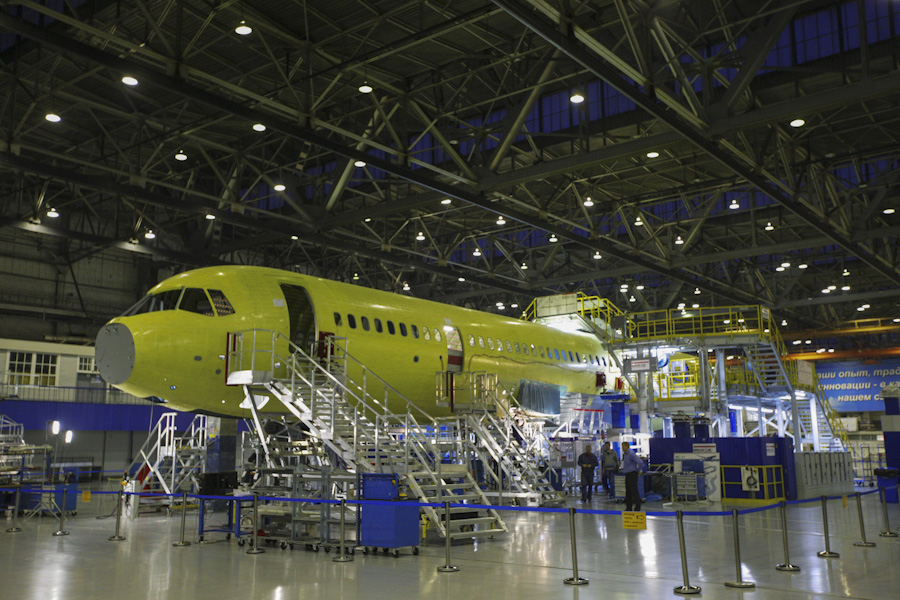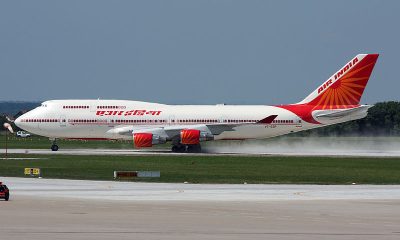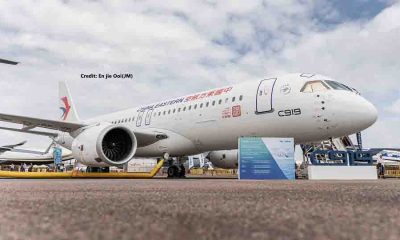Aviation
Uber reveals its flying taxi prototype for UberAir 2020 I UBER skyport

Uber reveals its flying taxi prototype for UberAir 2020 I UBER skyport
Uber Technologies Inc on Wednesday re-opened a contest to select the first international city to launch its proposed flying taxi project, following apparent delays in getting the service off the ground in Dubai, a previously proposed market.
UberAIR, as the service will be known, aims to launch demonstrator flights starting in 2020 and begin paid, intra-city operations in 2023, the company said.
Last year, Uber named Dallas and Los Angeles as its first launch cities and is now looking for a third, international metropolis to take part, Chief Product Officer Jeff Holden announced at its annual Elevate Summit in Los Angeles.
The company said it will consider cities with a metropolitan population of greater than 2 million people, with dispersed population hubs, an airport at least an hour away from the city centre and which is willing to back pooled ridesharing services.
Uber previously named Dubai as its third launch city but said on Tuesday it had reopened its selection process to include other cities which fit more of its criteria for showcasing how flying taxis can help to relieve urban congestion.
“Dubai has previously expressed an interest in (Uber’s) vision but we are broadening the pool given interest from other cities which is why we have launched this criteria and process,” a spokeswoman said, adding that discussions with Dubai continue.
Uber aims to speed development of a new industry of electric, on-demand, urban air taxis, which customers might order up via smartphone much the way it has popularised ground-based taxi alternatives since it first launched in 2011.

Aerospace
Pakistan’s Ambitious Plan to Acquire and Produce Chinese FC-31 Stealth Fighter

Pakistan is embarking on an ambitious endeavor to bolster its air defense capabilities with the acquisition and potential local production of the Chinese FC-31 stealth fighter jet.
Talks are reportedly underway between the Pakistan Air Force (PAF) and the Shenyang Aircraft Corporation, the developer of the FC-31, signaling a significant leap forward for Pakistan’s military aviation prowess.
The FC-31, a mid-sized, twin-engine fifth-generation fighter, promises advanced air combat capabilities, including stealth technology that surpasses anything currently in the PAF‘s fleet. With plans to retire the JF-17 production line by 2030, the FC-31 could emerge as the new flagship aircraft, offering unmatched performance and versatility.
Experts speculate that Pakistan’s interest in the FC-31 could also signal broader implications for the international market. As China develops both land and carrier versions of the FC-31, analysts foresee it becoming a cost-effective alternative to pricier options like the F-35, potentially challenging the dominance of the US aerospace industry and reshaping global strategic rivalries.
Adding complexity to the deal is China’s push for the WS-13 engine, previously rejected for the JF-17 but now under consideration for both the FC-31 and future JF-17 variants. Engine standardization could streamline logistical and maintenance processes for the PAF, further enhancing the appeal of the FC-31.
While negotiations continue, the success of the FC-31 acquisition and local production hinges on several factors, including the outcome of the WS-13 engine discussions. Pakistan’s pursuit of the FC-31 comes amidst its eagerness to replace its aging fleet, with previous attempts to upgrade its F-16s by the United States due to geopolitical pressures.
Amidst these developments, Pakistan previous interest in the Turkish-made Kaan fifth-generation fighter underscores its eagerness to replace its aging fleet. Despite previous attempts to secure upgrades for its F-16s from the United States, Pakistan’s quest for advanced aerial capabilities has led it to explore alternative avenues, with the FC-31 emerging as a promising contender in its pursuit of air superiority.
Aviation
China’s Indigenous HH-100 UAS Successfully Completes First Flight

In a significant milestone for China’s aviation industry, the HH-100 aerial commercial unmanned transportation system successfully completed its maiden flight, as announced by the Aviation Industry Corporation of China (AVIC) on Wednesday.
The HH-100 demonstrator took to the skies for its inaugural flight at a general aviation airport in Xi’an, located in northwest China’s Shaanxi Province. This successful test was conducted by AVIC, China’s leading aircraft manufacturer, marking a pivotal step in the development of the country’s unmanned aerial vehicle (UAV) capabilities.
Developed independently by AVIC XAC Commercial Aircraft Co., Ltd., a subsidiary of AVIC based in Xi’an, the HH-100 consists of two main components: an unmanned aerial vehicle and a ground-based command-and-control station. This innovative system is designed to offer a cost-effective, high-payload solution for various transportation and logistical needs.
The HH-100 is notable for its low cost and large tonnage capabilities. With a designed maximum take-off weight of 2,000 kilograms and a payload capacity of 700 kilograms, it can transport approximately 4 cubic meters of cargo over a range of 520 kilometers. The drone’s maximum cruise speed is 300 kilometers per hour, and it can operate at altitudes up to 5,000 meters.
Primarily intended for feeder logistics, the HH-100 is also equipped to participate in a variety of other roles, including forest and grassland firefighting, fire monitoring, transportation and delivery of rescue materials, relay communication, and artificial rain enhancement. This versatility makes it a valuable asset in both commercial and emergency response operations.
Looking ahead, AVIC plans to develop a series of products based on the HH-100 platform, with models capable of carrying 5 tons, 10 tons, and even larger payloads. These future developments aim to meet the growing demand for large-scale, intelligent, low-cost, and highly reliable unmanned cargo planes.
The HH-100’s successful first flight marks an important achievement for AVIC and China’s aviation sector, showcasing the potential of homegrown technology to advance the country’s capabilities in unmanned aerial transportation. With its impressive range of features and applications, the HH-100 is poised to play a significant role in enhancing air-ground transportation connectivity and addressing various logistical challenges in the region.
Aviation
Russia’s Venture into Spare Parts Production for Western-Made Jets

In a strategic move to mitigate the challenges posed by the shortage of spare parts for foreign-made passenger aircraft, Russian carriers are charting a new course by turning to domestic alternatives. At the forefront of this shift are two groundbreaking projects unveiled at the St. Petersburg International Economic Forum on June 6.
Leading the charge is Protektor Group, a prominent Russian MRO provider, which has committed a substantial investment of RUB3.5 billion ($39 million) to establish a cutting-edge facility near Moscow Domodedovo airport.
This facility is slated to specialize in the production of spare parts tailored for Airbus A320 and Boeing 737 narrowbody jets, with operations expected to commence in 2026. With a projected workforce of 800 employees, the facility aims to address the pressing demand for critical components in the aviation sector.
This initiative aligns seamlessly with broader governmental endeavors outlined in June 2022, which envisioned the manufacture of 1,036 airplanes using solely Russian parts by 2030. Bolstering this ambition, the state allocated a substantial sum of 283 billion rubles (U.S. $3.1 billion) in January 2024 to propel the production of 609 aircraft, with a particular emphasis on medium-haul models.
Protektor’s trajectory towards this pivotal milestone has been marked by notable achievements, including receiving production organization approval from Rosaviatsia in 2024. Prior to this, the company had earned certification for the overhaul of landing gear for Boeing 737s, solidifying its position as a trusted entity in aircraft maintenance.
Beyond the realm of spare parts production, the Russian aviation industry is poised for a significant transformation as it gears up to redefine its identity. Sergey Chemezov, the head of Rostec, the state-owned conglomerate overseeing aerospace, engineering, and defense sectors, has unveiled ambitious plans to resurrect the renowned ‘Yakovlev‘ brand. This rebranding initiative extends across the spectrum of Russian-made airliners, signaling a new era of innovation and prominence.






















